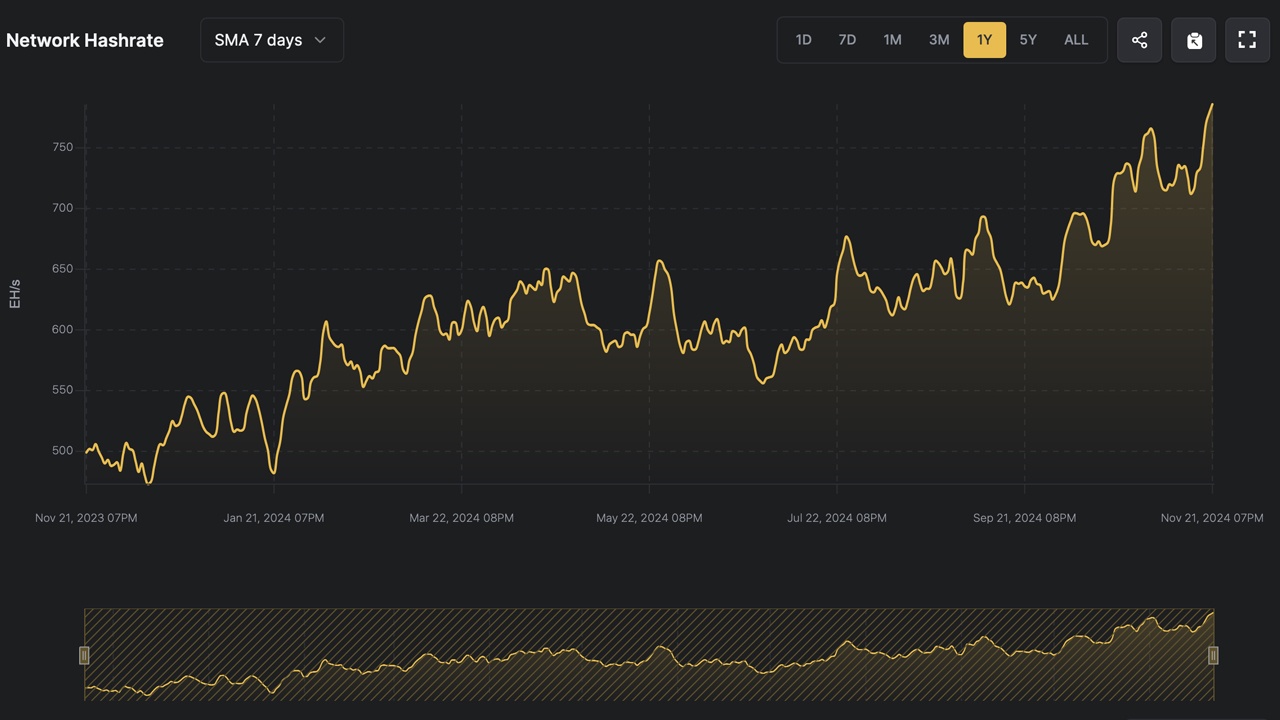Bitcoin Mining Hashrate Soars: Analysis Of The Recent Rise

Table of Contents
Factors Contributing to the Increased Bitcoin Mining Hashrate
Several converging factors have contributed to the recent explosion in Bitcoin mining hashrate. Let's explore the key drivers:
The Role of Institutional Investment
Increased institutional adoption of Bitcoin has fueled demand, directly impacting the Bitcoin mining hashrate. Large financial institutions and corporations are increasingly viewing Bitcoin as a valuable asset, leading to significant investments in Bitcoin mining infrastructure. This translates into the establishment of large-scale mining operations, significantly boosting the overall network hashrate.
- Examples: Several publicly traded companies have invested heavily in Bitcoin mining, including Marathon Digital Holdings and Riot Platforms. These companies have expanded their mining operations, purchasing significant quantities of ASIC miners and securing large-scale energy contracts.
- Impact: This influx of institutional capital has resulted in a substantial increase in mining capacity, directly contributing to the rise in Bitcoin mining hashrate. Their access to capital and economies of scale enables them to compete effectively and expand operations rapidly.
Technological Advancements in Mining Hardware
Advancements in mining hardware have played a crucial role. The development of more efficient Application-Specific Integrated Circuits (ASICs) has allowed miners to process transactions faster and more cost-effectively. Coupled with improved cooling technologies, these advancements have significantly increased the hash power per unit of energy consumed.
- Specific Advancements: The introduction of newer generations of ASIC miners with improved hashing algorithms and power efficiency has led to a dramatic increase in mining capacity. Innovations in chip design and manufacturing processes have also contributed.
- Impact: These technological leaps enable miners to achieve higher hash rates with lower energy consumption, making Bitcoin mining more profitable and attractive, thus driving up the overall network hashrate.
Geopolitical Factors and the Regulatory Landscape
Geopolitical factors and the regulatory landscape significantly influence where Bitcoin mining operations are established. Regions with favorable energy policies, particularly those offering access to cheaper renewable energy sources, become attractive hubs for mining activity. Conversely, regions with stringent regulations or high energy costs tend to see a decline in mining operations.
- Impact of Energy Policies: Regions with abundant hydropower, geothermal energy, or cheap solar and wind power are attracting significant mining investments. These areas benefit from lower operational costs and a sustainable energy approach.
- Regulatory Changes: Changes in regulatory frameworks around the world impact mining activity. Countries with clear, supportive regulations tend to attract more miners, while uncertain or restrictive regulatory environments may discourage investment. For example, China's crackdown on Bitcoin mining in 2021 led to a significant shift in mining operations to other regions.
Bitcoin Price and Miner Profitability
The price of Bitcoin is intrinsically linked to miner profitability and directly influences the Bitcoin mining hashrate. When the Bitcoin price rises, mining becomes more profitable, incentivizing more miners to participate and increasing the network's hashrate. Conversely, a price drop reduces profitability, potentially leading to a decrease in mining activity.
- Correlation: Historically, there's a strong positive correlation between Bitcoin's price and its hashrate. As the price increases, miners are more incentivized to invest in new equipment and expand operations.
- Profitability Threshold: Miners need to operate above a certain profitability threshold to remain active. Factors like electricity costs, hardware costs, and transaction fees all contribute to this threshold. When the price drops below this threshold, some miners might choose to shut down their operations.
Implications of the Increased Bitcoin Mining Hashrate
The surge in Bitcoin mining hashrate carries significant implications for the Bitcoin network and its ecosystem:
Enhanced Network Security
A higher hashrate directly translates to enhanced network security. The increased computational power makes it exponentially more difficult for malicious actors to launch a 51% attack—a scenario where a single entity controls over half of the network's hashing power and could potentially manipulate the blockchain.
- Resistance to Attacks: The higher hashrate significantly raises the bar for any attempt to reverse transactions or double-spend Bitcoin. It strengthens the integrity and security of the entire Bitcoin network.
- Improved Trust: A secure network fosters trust among users, contributing to the overall stability and adoption of Bitcoin.
Decentralization and its Challenges
While a high hashrate contributes to security, it also presents challenges to decentralization. The concentration of mining power in specific regions or among a few large entities could raise concerns about the network's resilience and its susceptibility to potential manipulation.
- Geographic Concentration: The majority of Bitcoin mining hashrate may be geographically concentrated in a few regions, creating potential vulnerabilities.
- Maintaining Decentralization: Strategies to promote decentralization, such as supporting smaller mining pools and promoting geographically diverse mining operations, are crucial to mitigating this risk.
Impact on Bitcoin's Price and Volatility
The relationship between the Bitcoin mining hashrate and its price is complex and not always directly proportional. While a higher hashrate generally signifies greater network security and potentially increased adoption, its impact on price volatility is less clear-cut.
- Price Prediction: The increased hashrate could contribute to price stability in the long term by enhancing the security and resilience of the Bitcoin network. However, short-term price fluctuations can still occur based on other market factors.
Conclusion
The recent surge in Bitcoin mining hashrate is a multifaceted phenomenon with significant consequences. Institutional investment, technological progress, geopolitical dynamics, and Bitcoin's price all play crucial roles. While this increase substantially enhances network security, it also necessitates a careful consideration of decentralization challenges. Understanding these interconnected factors is crucial for navigating the evolving landscape of Bitcoin. To stay abreast of these developments and their impact on the cryptocurrency market, consistently monitor the Bitcoin mining hashrate and its implications for the future of this leading digital asset. Stay updated on all things related to the Bitcoin mining hashrate and its influence on the cryptocurrency market.

Featured Posts
-
 Trump Appoints Casey Means A Leader In The Maha Movement As Surgeon General
May 09, 2025
Trump Appoints Casey Means A Leader In The Maha Movement As Surgeon General
May 09, 2025 -
 Bitcoin Madenciliginin Sonu Mu Analiz Ve Tahminler
May 09, 2025
Bitcoin Madenciliginin Sonu Mu Analiz Ve Tahminler
May 09, 2025 -
 Analiza E 11 Zbulimi I Sekretit Te Suksesit Te Psg Se
May 09, 2025
Analiza E 11 Zbulimi I Sekretit Te Suksesit Te Psg Se
May 09, 2025 -
 Car Crash At Jennifer Anistons Home Leads To Felony Charges
May 09, 2025
Car Crash At Jennifer Anistons Home Leads To Felony Charges
May 09, 2025 -
 New Evidence Emerges In Wynne Evans Strictly Scandal Case
May 09, 2025
New Evidence Emerges In Wynne Evans Strictly Scandal Case
May 09, 2025
